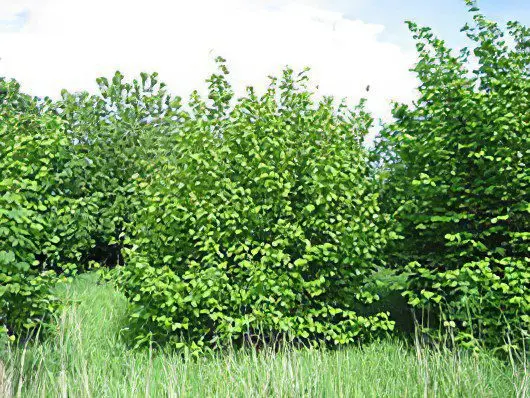Contents
Reproduction, care and recipes for the use of beneficial properties of hazel
Botanical characteristics of hazel

Hazel is a tall shrub that belongs to the hazel family. The brown branches of the plant have white lenticels on their surface. The buds of the hazel are rounded, slightly compressed from all sides. The leaves sit on short petioles, their shape is similar to an egg. The leaves have a point, and their edges are serrated. The staminate flowers of the plant are located in the catkins, but the pistillate flowers are in the flower buds. The fruit of the hazel is a nut of a brownish-yellow color, which is located in a green plush. This shrub is long-lived, it can live for about 80 years. In April, the flowering of hazel begins, after which the leaves begin to bloom. Fruit ripening occurs at the end of summer.
Hazel is a common plant in the steppe and forest-steppe zones of the CIS. The Caucasus is another place where hazel grows. This shrub prefers fertile soils, mixed forests, edges and ravines.
Hazel propagation
Hazel reproduces by layering, stump shoots, seeds and root offspring. For example, if you want to grow a decorative hazel, then it needs to be propagated by layering. The seed method of reproduction involves sowing ripened seeds in ready-made soil. Before sowing, the seeds must be moistened with kerosene – this is necessary to protect against rodents. If the region is arid, then before planting, the seeds should be stratified, and then sown in the ground (in autumn). For spring sowing of seeds, the following must be done: soak the seeds for 5 days, then 4 months they are stratified in the sand. Almost at the end of stratification, the seeds must be placed under the snow, and then they are already sown in the ground.
Hazel care
Hazel is not able to tolerate sandy soils and waterlogging. This shrub requires a drainage layer consisting of crushed stone. Before the appearance of the first leaves, it is necessary to add fertilizers to the soil, namely mullein, saltpeter, urea.
During the planting period, the plant needs watering. And for 4 days after planting, the hazel also needs to be watered. As weeds appear, they must be removed, while simultaneously loosening the soil.
Hazel is resistant to winds and shade, however, in the presence of cold winds and shade, the plant will give a small crop. Based on this, it becomes clear that it is better to plant hazel in a sunny and sheltered place from the winds. To get a bountiful harvest, you just need to plant a few hazel bushes nearby.
Useful properties of hazel
Hazel leaves contain sucrose, essential oil and myricitrosil. The fruits of this plant are rich in vitamins, proteins and sugars, mineral salts and fats. Nuts have an immunostimulating effect. Hazel fruits are useful for people with diabetes, hypertension and atherosclerosis. Nuts contribute to the production of milk in lactating women. Hazel is a laxative, so it is used for constipation. The plant has antipyretic and astringent properties. Hazel is used as a means that dilates blood vessels. This medicinal plant dissolves kidney stones, stimulates all body functions.
Application of hazel

In folk medicine, the fruits, roots, leaves and bark of the plant are used. A decoction of hazel is used for malaria. Infusion of the bark of this shrub helps with varicose veins, varicose ulcers, capillary hemorrhages. Hazel leaves are an excellent remedy for beriberi, rickets, intestinal diseases and anemia. A decoction prepared on the basis of leaves helps with kidney diseases, hypertension.
The fruits of the plant are used for epilepsy or cholelithiasis. A decoction of their shells is used for colitis. Fruits in relation to honey help with rheumatism, tumors and ascariasis.
Hazel fruits are recommended for people who have undergone surgery, a serious infectious disease, or simply for children to strengthen their condition and stimulate development.
Hazel juice for anemia. To prepare it, you need to take fresh young leaves of the plant, which are at the last stage of flowering, and make a spin out of them. Ready juice should be taken in 2 tablespoons, which are pre-mixed with two tablespoons of honey. Take this juice no more than 5 times a day before meals.
A decoction of hazel for diarrhea. Take 10 grams of dry plush and fill them with 100 ml of boiling water. Place the composition for a quarter of an hour on a low fire. After removing from the heat, leave the product to brew for 2 hours. After straining, the decoction can be used 50 ml 4 times a day.
Infusion of bark and leaves of hazel. To prepare it, you will need 20 grams of crushed leaves and bark, pour 200 ml of boiling water. Leaving the medicine for 4 hours to brew, filter. Take this infusion should be 50-60 ml no more than four times a day.
Contraindications to the use of hazel
There are no contraindications to the use of this plant, except for individual intolerance to hazel.









